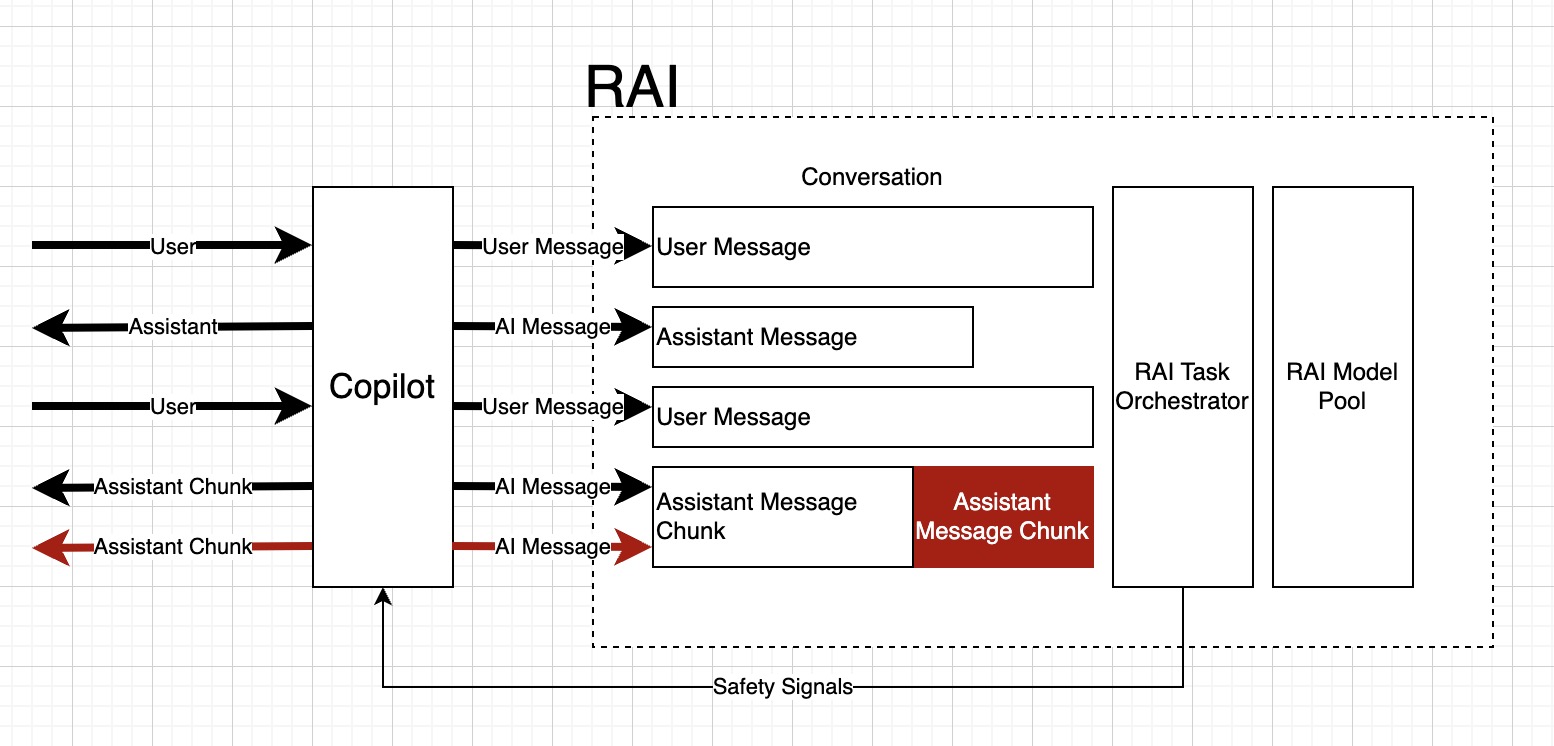Integration Guide¶
Overview¶
The Responsible AI (RAI) platform aims to facilitate seamless integration with various partners by providing flexible deployment options and standardized integration protocols. This document outlines the key aspects of integration, focusing on the deployment model and the methods for interaction between partners and the RAI platform.
Target Audience¶
The RAI platform is designed to support two primary user groups:
AOAI Service Teams¶
This includes internal partners within the AOAI organization, such as teams developing CMP, DALL·E, GPT-V, RealtimeAPI, and AgentAPI services.
AOAI Customer Team¶
These are users leveraging AOAI services to develop AI services or Copilot solutions for end-users.
The RAI Platform Provisioning Options¶
Unified Region Deployment¶
This option is only available for AOAI Service Teams because Responsible AI is part of Azure OpenAI. The RAI platform offers unified region deployment and a centralized endpoint. This simplifies integration and ensures consistent performance and compliance.
Benefits:
- Centralized Management: Unified endpoint and policy management by RAI.
- Policy Consistency: Shared policies across AOAI internal services ensure alignment and streamlined operations.
Standard Azure Resource Creation¶
For both AOAI Service Team and AOAI Customer Team, the RAI platform provides a standardized Azure Resource creation process. This allows users to configure resources tailored to their specific needs while maintaining compatibility with the RAI platform.
Benefits:
- Customizability: Enables users to define proprietary policies tailored to their specific requirements.
- Flexibility: Supports diverse use cases and organizational needs.
For mode details, please refer to Provisioning.¶
Integration Methods¶
Protocol Support¶
The RAI platform supports two primary communication protocols:
-
HTTP: A widely-used protocol suitable for standard API-based integrations. Client will send a policy and whole conversation in one HTTP request, RAI service will return the annotation result in the response. HTTP API reference
-
gRPC: A high-performance, low-latency protocol designed for streaming and real-time processing. gRPC API reference (Standard Mode) | gRPC API reference (AOAI Protocol Alignment Mode)

Integration Modes More details¶
The RAI platform provides two primary integration modes, each designed to address specific customer requirements. Below is a detailed comparison of the AOAI Protocol Alignment Mode and the Standard Protocol Mode.
AOAI Protocol Alignment Mode¶
In this mode, customers interact directly with the AOAI protocol by forwarding user requests and AOAI responses to the RAI platform via a gRPC stream without modifications. The RAI platform manages conversation context in real-time, analyzing content and providing detection results and watermarks.
Supported APIs¶
- Completion API
- Chat API
- Real-Time API
- Image Creation API
- Agent API
Benefits¶
- Simplicity: Minimal processing required; data is passed through without transformation.
- Efficiency: Real-time streaming ensures low latency for detection results and watermarks.
- Bandwidth Optimization: Optional exclusion of unnecessary usage details reduces data overhead.
- Compatibility: Seamless integration for AOAI customers leveraging existing protocols.
Standard Protocol Mode¶
This mode allows customers to structure user-AI interactions into a "messages" payload following a specified protocol. The payload is sent to the RAI platform’s API endpoint for processing, focusing on content and user identity to optimize performance and bandwidth usage.
Benefits¶
- Flexibility: Enables customers to integrate custom workflows and data structures with the RAI platform.
- Standardization: Ensures compatibility across diverse systems with a defined protocol.
- Customizability: Allows payload enrichment with additional context or metadata for improved analysis.
Comparison Table¶
| Feature | AOAI Protocol Alignment Mode | Standard Protocol Mode |
|---|---|---|
| Ease of Integration | High - No transformation required | Moderate - Requires structuring |
| Latency | Low - Real-time processing | Low - Real-time processing |
| Flexibility | Low - Fixed protocol | High - Customizable payloads |
| Target Audience | AOAI Service Teams | AOAI Service Teams & Customers |
| Bandwidth Optimization | High | Moderate |
| Customizability | Low | High |
Summary¶
Both integration modes cater to specific use cases and operational needs. The AOAI Protocol Alignment Mode is highly suitable for AOAI Service Teams requiring real-time, seamless integration with minimal modifications. It excels in efficiency and bandwidth optimization. On the other hand, the Standard Protocol Mode provides unmatched flexibility and customizability, making it ideal for both AOAI Service Teams and external customers who need tailored workflows and additional metadata for analysis. By understanding the strengths of each mode, users can select the approach that best aligns with their technical and business requirements.